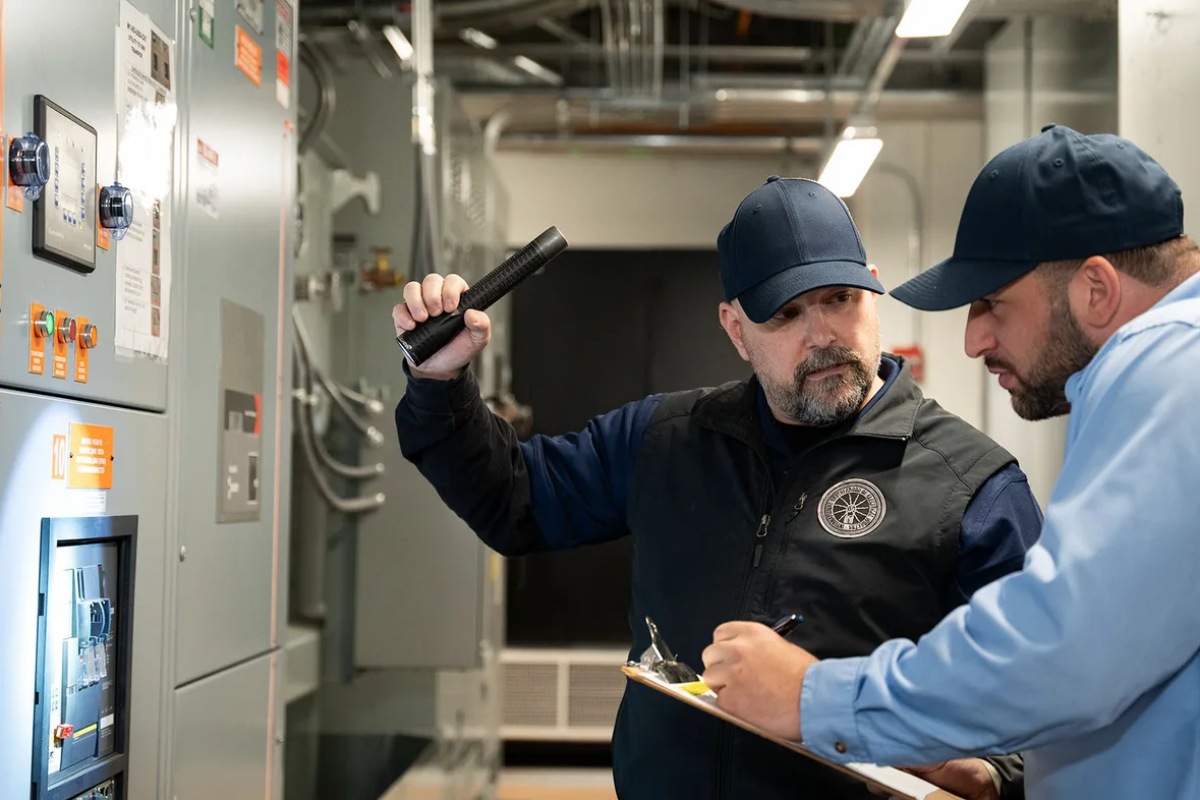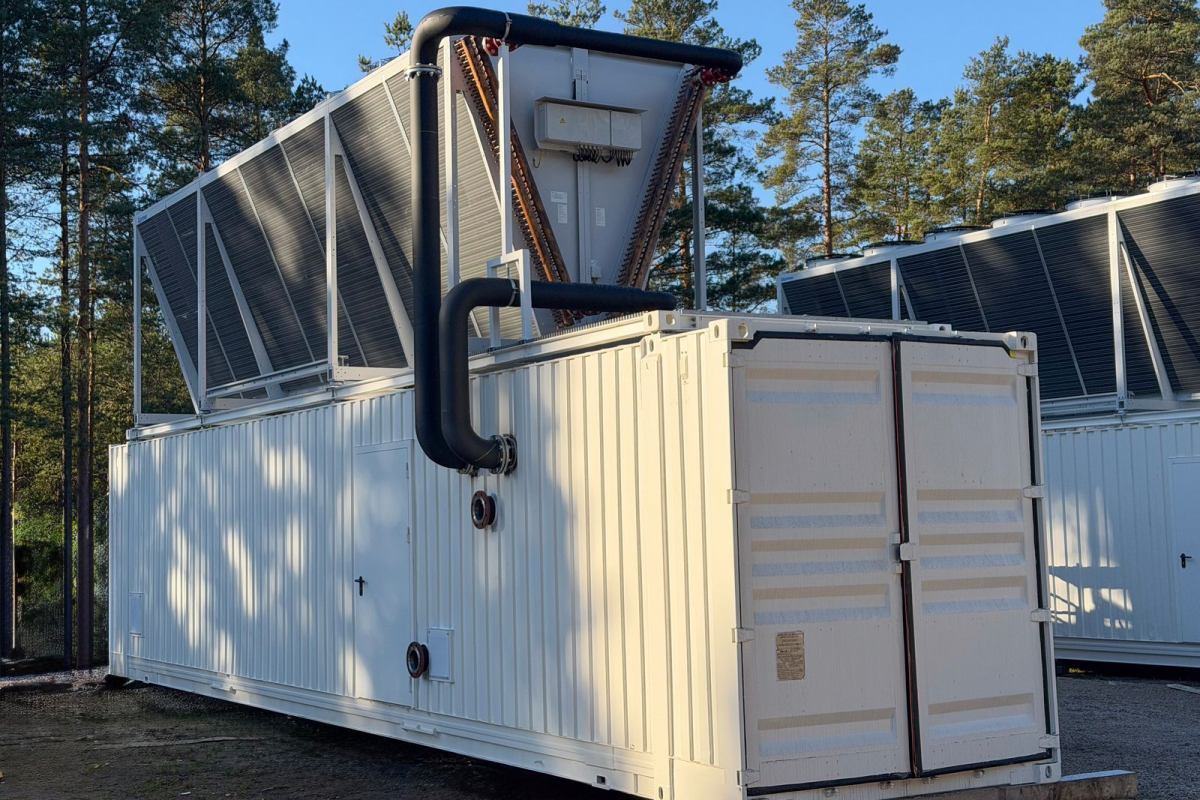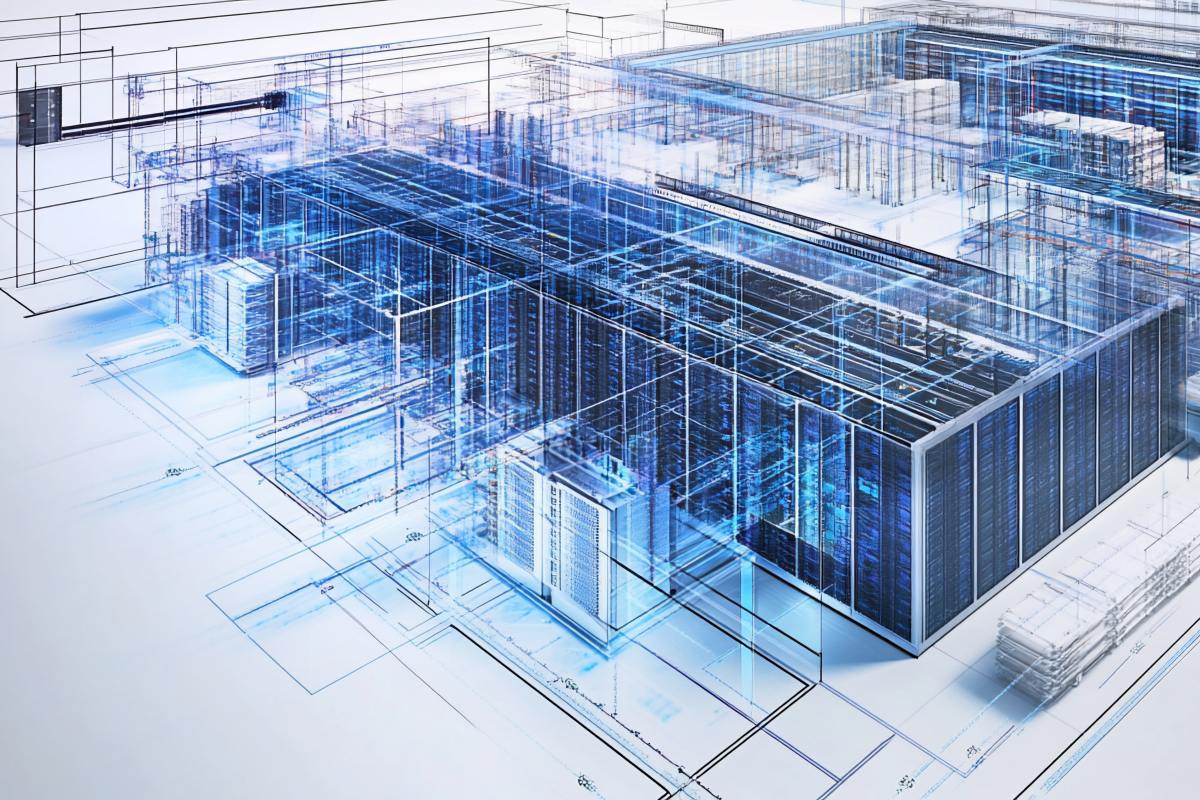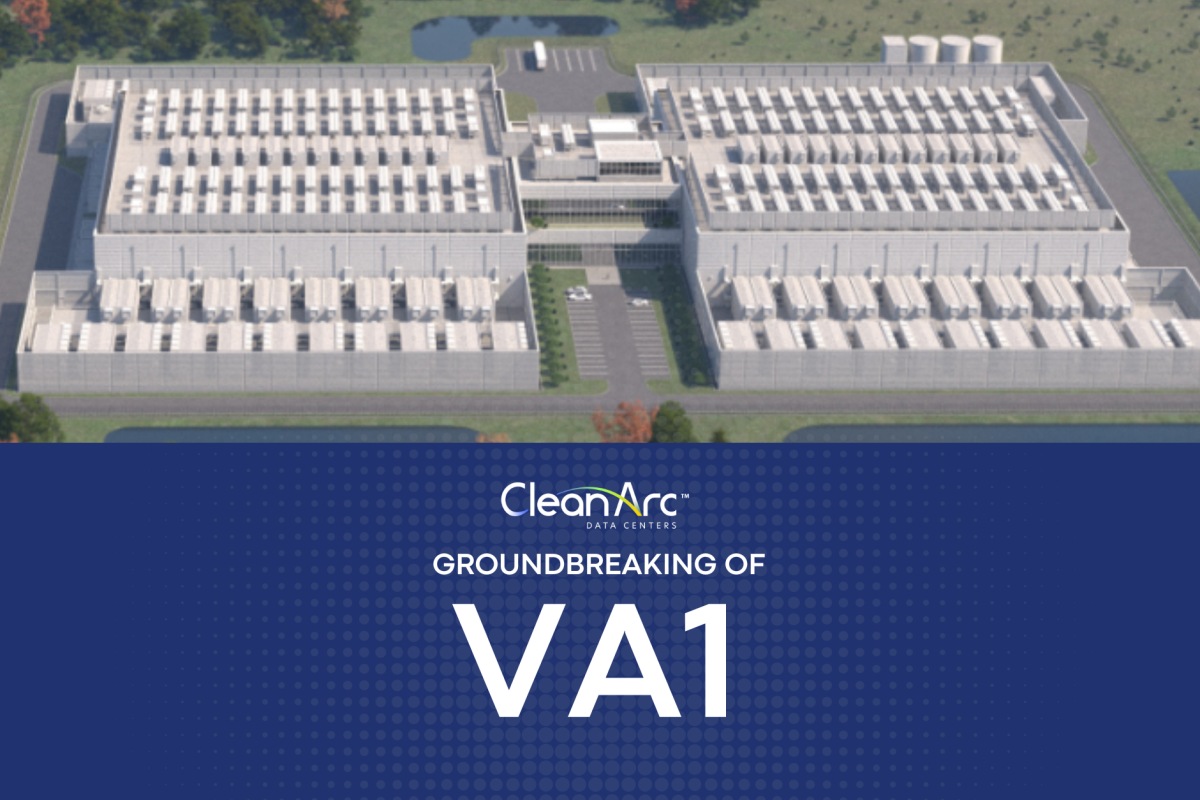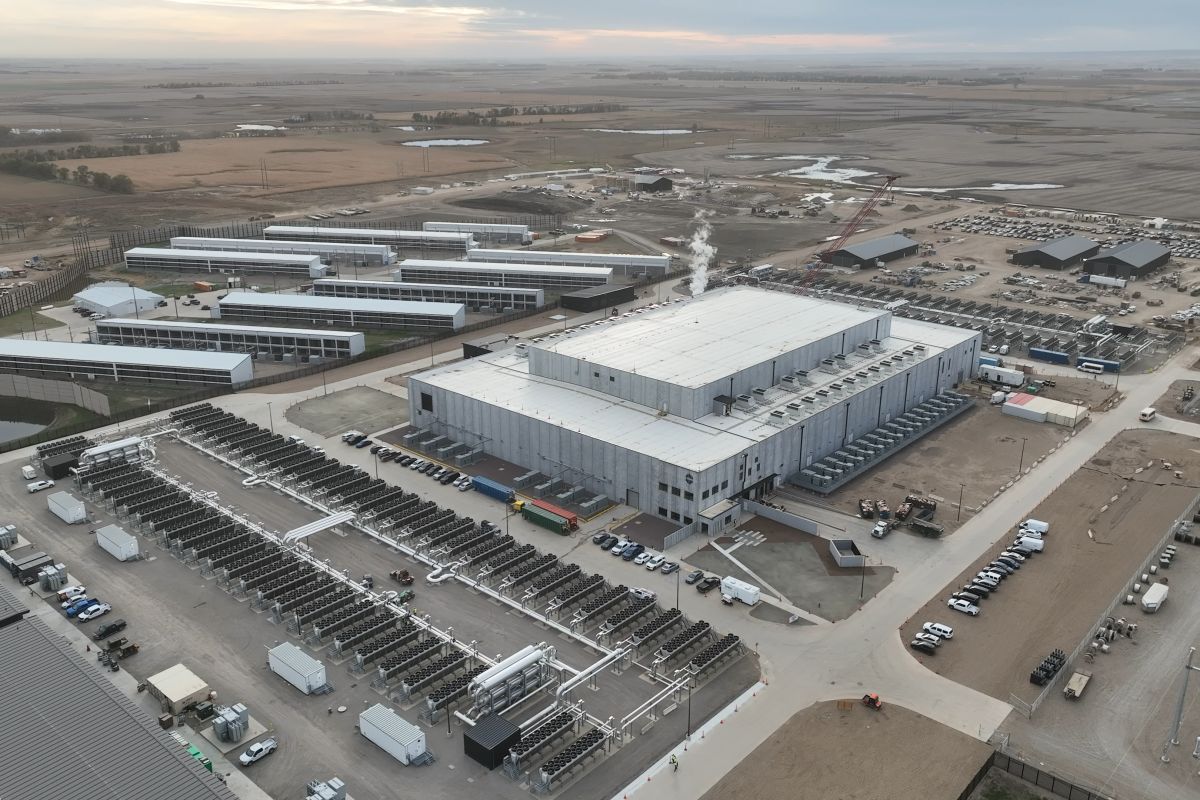Data Centre Operations: Optimising Infrastructure for Performance and Reliability
Data Centre Build News & Insights
Data Centre Operations: Optimising Infrastructure for Performance and Reliability
Data Centre Projects: Infrastructure Builds, Innovations & Updates
Modular Data Centres in the UK: Scalable, Smart Infrastructure
Vertiv, GreenScale to deploy DC platforms across Europe
Vertiv, a global provider of critical digital infrastructure, and GreenScale, a developer of hyperscale data centre campuses, have announced a strategic collaboration to deliver factory-integrated data centre platforms engineered for next-generation AI workloads in Europe.
Following a competitive pre-qualification questionnaire (PQQ) process, GreenScale selected Vertiv as its preferred provider for standardised, prefabricated Vertiv OneCore hybrid-built data centres.
While GreenScale will manage slab-down construction and site-wide infrastructure, Vertiv will provide AI-ready data centre modules engineered to support liquid-cooled deployments of NVIDIA Grace Blackwell GB200/300 graphic processing units (GPUs), including next-generation Vera Rubin GPUs.
Vedran Brzic, VP Infrastructure Solutions Business EMEA at Vertiv, says, “AI workloads demand density and speed. By integrating the Vertiv OneCore platform into GreenScale’s standard design, we can help to accelerate deployment of scalable infrastructure for AI, high-performance (HPC), and high-density computing.
"Our scalable prefabricated solution integrates our proven power, thermal, and IT infrastructure into a single factory-assembled system that can help customers deploy high-density capacity more efficiently while increasing reliability and performance.”
Vertiv's OneCore platform
The Vertiv OneCore platform supports up to 200+ kW per rack and features coolant distribution units (CDUs) with a dual-loop liquid cooling system.
The platform is supported by Vertiv SmartRun overhead prefabricated infrastructure, which includes an integrated secondary fluid network (SFN) for liquid-cooled thermal management - optimised for GPU-intensive architectures - and power distribution.
Modules arrive factory-built and pre-tested, with GreenScale providing comprehensive site services including grid integration, permitting, battery monitoring system (BMS)/security systems, and slab-down construction.
Dan Thomas, CEO at GreenScale, comments, “Our collaboration with Vertiv aligns perfectly with GreenScale’s mission to rapidly deploy high efficiency, AI-ready infrastructure across Europe. By standardising on Vertiv’s prefabricated platforms, we gain significant advantages in speed-to-market, quality control, and operational efficiency.
"Their proven experience in high-density cooling solutions and factory-integrated approach helps us minimise on-site complexity while enabling our facilities to be optimised for the most demanding AI workloads. This standardised platform approach will be instrumental in executing our ambitious expansion plans across Northern Ireland and the Nordics.”
GreenScale plans to expand with approximately 120 MW in Northern Ireland and over 300 MW across the Nordics, with a long-term vision to deploy close to 1 GW across Europe.
The company says it aims to implement a high-performance compute model that aligns its objectives and timelines with "technology providers who can efficiently deliver scalable, AI-ready solutions."
For more from Vertiv, click here.
Joe Peck - 17 December 2025
Artificial Intelligence in Data Centre Operations
Data Centre Build News & Insights
Data Centre Operations: Optimising Infrastructure for Performance and Reliability
Data Centre Projects: Infrastructure Builds, Innovations & Updates
Sabey's Manhattan facility becomes AI inference hub
Sabey Data Centers, a data centre developer, owner, and operator, has said that its New York City facility at 375 Pearl Street is becoming a hub for organisations running advanced AI inference workloads.
The facility, known as SDC Manhattan, offers dense connectivity, scalable power, and flexible cooling infrastructure designed to host latency-sensitive, high-throughput systems.
As enterprises move from training to deployment, inference infrastructure has become critical for delivering real-time AI applications across industries.
Tim Mirick, President of Sabey Data Centers, says, "The future of AI isn't just about training; it's about delivering intelligence at scale. Our Manhattan facility places that capability at the edge of one of the world's largest and most connected markets.
"That's an enormous advantage for inference models powering everything from financial services to media to healthcare."
Location and infrastructure
Located within walking distance of Wall Street and major carrier hotels, SDC Manhattan is among the few colocation providers in Manhattan with available power. The facility has nearly one megawatt of turnkey power available and seven megawatts of utility power across two powered shell spaces.
The site provides access to numerous network providers as well as low-latency connectivity to major cloud on-ramps and enterprises across the Northeast.
Sabey says it offers organisations the ability to deploy inference clusters close to their users, reducing response times and enabling real-time decision-making.
The facility's liquid-cooling-ready infrastructure supports hybrid cooling configurations to accommodate GPUs and custom accelerators.
For more from Sabey Data Centers, click here.
Joe Peck - 10 December 2025
Artificial Intelligence in Data Centre Operations
Data Centre Operations: Optimising Infrastructure for Performance and Reliability
Features
News in Cloud Computing & Data Storage
Europe races to build its own AI backbone
Recent outages across global cloud infrastructure have once again served as a reminder of how deeply Europe depends on foreign hyperscalers. When platforms run on AWS or services protected by Cloudflare fail, European factories, logistics hubs, retailers, and public services can stall instantly.
US-based cloud providers currently dominate Europe’s infrastructure landscape. According to market data, Amazon, Microsoft, and Google together control roughly 70% of Europe’s public cloud market. In contrast, all European providers combined account for only about 15%. This share has declined sharply over the past decade. For European enterprises, this means limited leverage over resilience, performance, data governance, and long-term sovereignty.
This same structural dependency is now extending from cloud infrastructure directly into artificial intelligence and its underlying investments. Between 2018 and 2023, US companies attracted more than €120 billion (£104 billion) in private AI investment, while the European Union drew about €32.5 billion (£28 billion) over the same period.
In 2024 alone, US-based AI firms raised roughly $109 billion (£81 billion), more than six times the total private AI investment in Europe that year. Europe is therefore trying to close the innovation gap while simultaneously tightening regulation, creating a paradox in which calls for digital sovereignty grow louder even as reliance on non-European infrastructure deepens.
The European Union’s Apply AI Strategy is designed to move AI out of research environments and into real industrial use, backed by more than one billion euros in funding. However, most of the computing power, cloud platforms, and model infrastructure required to deploy these systems at scale still comes from outside Europe. This creates a structural risk: even as AI adoption accelerates inside European industry, much of the strategic control over its operation may remain in foreign hands.
Why industrial AI is Europe’s real monitoring ground
For any large-scale technology strategy to succeed, it must be tested and refined through real-world deployment, not only shaped at the policy level. The effectiveness of Europe’s AI push will ultimately depend on how quickly new rules, funding mechanisms, and technical standards translate into working systems, and how fast feedback from practice can inform the next iteration.
This is where industrial environments become especially important. They produce large amounts of real-time data, and the results of AI use are quickly visible in productivity and cost. As a result, industrial AI is becoming one of the main testing grounds for Europe’s AI ambitions. The companies applying AI in practice will be the first to see what works, what does not, and what needs to be adjusted.
According to Giedrė Rajuncė, CEO and co-founder of GREÏ, an AI-powered operational intelligence platform for industrial sites, this shift is already visible on the factory floor, where AI is changing how operations are monitored and optimised in real time.
She notes, “AI can now monitor operations in real time, giving companies a new level of visibility into how their processes actually function. I call it a real-time revolution, and it is available at a cost no other technology can match. Instead of relying on expensive automation as the only path to higher effectiveness, companies can now plug AI-based software into existing cameras and instantly unlock 10–30% efficiency gains.”
She adds that Apply AI reshapes competition beyond technology alone, stating, “Apply AI is reshaping competition for both talent and capital. European startups are now competing directly with US giants for engineers, researchers, and investors who are increasingly focused on industrial AI. From our experience, progress rarely starts with a sweeping transformation. It starts with solving one clear operational problem where real-time detection delivers visible impact, builds confidence, and proves return on investment.”
The data confirms both movement and caution. According to Eurostat, 41% of large EU enterprises had adopted at least one AI-based technology in 2024. At the same time, a global survey by McKinsey & Company shows that 88% of organisations worldwide are already using AI in at least one business function.
“Yes, the numbers show that Europe is still moving more slowly,” Giedrė concludes. “But they also show something even more important. The global market will leave us no choice but to accelerate. That means using the opportunities created by the EU’s push for AI adoption before the gap becomes structural.”
Joe Peck - 8 December 2025
Data Centre Build News & Insights
Data Centre Operations: Optimising Infrastructure for Performance and Reliability
Data Centre Projects: Infrastructure Builds, Innovations & Updates
Modular Data Centres in the UK: Scalable, Smart Infrastructure
Portable data centre to heat Scandinavian towns
Power Mining, a Baltics-based personal Bitcoin mining device manufacturer, has developed a portable data centre that will heat towns using residual heat from Bitcoin mining.
The first two data centres, housed in shipping containers, will be shipped to a Scandinavian town, where they will be connected to the municipal heating system.
In one year, one Power Mining data centre can reportedly mine up to 9.7 Bitcoin and heat up to 2000 homes. With 1.6 MW/h in power, the data centre achieves 95% energy efficiency, thereby providing the municipality with 1.52 MW/h.
A portable data centre design
The data centres are built in Latvia, at a cost starting from €300,000 (£262,000). Due to being put together in a shipping container, they are easily shipped around the world.
The data centre is made up of eight server closets, each outfitted with 20 Whatsminer M63S++ servers that consume 10kW of electricity each and create an equivalent amount of heat.
The servers can raise the incoming coolant temperature by 10-14°C, producing the equivalent amount of heat while mining Bitcoin.
Each server closet is equipped with warm and cool fluid collectors which send the warmed liquid to a built-in heat pump station, where a 1.7 MW heat exchanger ensures the redistribution of heat from the data centre to the town’s heating grid.
If the heating grid does not require additional heat from the data centre, the heated fluid is redirected to a built-in dry cooler, which adjusts the temperature to suit the needs of the servers. This way, the data centre is able to cool itself and also contribute to balancing the municipality’s heating grid.
Steps towards increased energy efficiency
The development of a passive heating data centre is one step towards increased energy efficiency in Bitcoin mining.
While classical data centres can collect heat at approximately 27°C, Power Mining says its data centres can collect heat up to 65°C, providing cities with more efficient sources of heat.
European data centres already make up more than 3% of the continent’s total electricity consumption, which is expected to surpass 150 TW/h annually - an equivalent of all of Poland’s electricity demands.
Up to 40% of this energy is turned into heat, which most often is released into the atmosphere. If this energy were collected and redirected back to heating, it could provide up to 10 million European households with heat.
Heat collection from data centres could become one of the most effective ways to combine digitalisation and climate goals.
Joe Peck - 5 December 2025
Artificial Intelligence in Data Centre Operations
Data Centre Operations: Optimising Infrastructure for Performance and Reliability
News
Study finds consumer GPUs can cut AI inference costs
A peer-reviewed study has found that consumer-grade GPUs, including Nvidia’s RTX 4090, can significantly reduce the cost of running large language model (LLM) inference.
The research, published by io.net - a US developer of decentralised GPU cloud infrastructure - and accepted for the 6th International Artificial Intelligence and Blockchain Conference (AIBC 2025), provides the first open benchmarks of heterogeneous GPU clusters deployed on the company’s decentralised cloud platform.
The paper, Idle Consumer GPUs as a Complement to Enterprise Hardware for LLM Inference, reports that clusters built from RTX 4090 GPUs can deliver between 62% and 78% of the throughput of enterprise-grade H100 hardware at roughly half the cost.
For batch processing or latency-tolerant workloads, token costs fell by up to 75%.
The study also notes that, while H100 GPUs remain more energy efficient on a per-token basis, extending the life of existing consumer hardware and using renewable-rich grids can reduce overall emissions.
Aline Almeida, Head of Research at IOG Foundation and lead author of the study, says, “Our findings demonstrate that hybrid routing across enterprise and consumer GPUs offers a pragmatic balance between performance, cost, and sustainability.
"Rather than a binary choice, heterogeneous infrastructure allows organisations to optimise for their specific latency and budget requirements while reducing carbon impact.”
Implications for LLM development and deployment
The research outlines how AI developers and MLOps teams can use mixed hardware clusters to improve cost-efficiency.
Enterprise GPUs can support real-time applications, while consumer GPUs can be deployed for batch tasks, development, overflow capacity, and workloads with higher latency tolerance.
Under these conditions, the study reports that organisations can achieve near-H100 performance with substantially lower operating costs.
Gaurav Sharma, CEO of io.net, comments, “This peer-reviewed analysis validates the core thesis behind io.net: that the future of compute will be distributed, heterogeneous, and accessible.
"By harnessing both data-centre-grade and consumer hardware, we can democratise access to advanced AI infrastructure while making it more sustainable.”
The company also argues that the study supports its position that decentralised networks can expand global compute capacity by making distributed GPU resources available to developers through a single, programmable platform.
Key findings include:
• Cost-performance ratios — Clusters of four RTX 4090 GPUs delivered 62% to 78% of H100 throughput at around half the operational cost, achieving the lowest cost per million tokens ($0.111–0.149).
• Latency profiles — H100 hardware maintained sub-55ms P99 time-to-first-token even at higher loads, while consumer GPU clusters were suited to workloads tolerating 200–500ms tail latencies, such as research, development environments, batch jobs, embeddings, and evaluation tasks.
Joe Peck - 4 December 2025
Artificial Intelligence in Data Centre Operations
Data Centre Business News and Industry Trends
Data Centre Operations: Optimising Infrastructure for Performance and Reliability
Data Centre Regulations & UK Compliance Updates
Insights into Data Centre Investment & Market Growth
UK Chancellor urged to use AI for economic growth
UK Chancellor Rachel Reeves has been urged to use the opportunity afforded by AI to ‘Make Britain Great Again’.
The news comes as the Government announced that thousands of new AI jobs and billions of pounds of investment will be poured into the next parliament to help stimulate economic growth.
New AI Growth Zones
Amongst the package of measures proposed for the budget today include a new AI Growth Zone in South Wales, which will create more than 5,000 new jobs for local communities over the next decade, and a further £137 million to support key scientists to drive breakthroughs and develop new drugs, cures, and treatments.
Patrick Sullivan, CEO of think tank Parliament Street, argued that with limited options at the budget, only AI can ‘Make Britain Great Again’.
He claims, “With limited options due to Labour’s absurd manifesto pledge to rule out income tax rises, the Chancellor is now forced to cobble together a quick fix solution to fill a black hole which is entirely of her own making.
"However, the one saving grace is the advent of mass AI adoption, a technology that will bring mass savings at a time when the Government needs it most.
“This is Labour’s chance to show that it gets private enterprise and recognises that by supporting tech talent, AI can truly Make Britain Great Again.”
Tech expert Graeme Stewart, Head of Public Sector at Check Point Software, says, “The case for investing billions in AI to drive growth and reboot the economy is clear, yet little has been said about the cyber and regulatory risks associated with mass adoption.
“Whether it’s attacks on the NHS, nurseries, or local councils, cyber criminals have already proven that nothing in the public sector is off limits. That’s why it’s vital the Chancellor’s AI rollout is backed up with a robust action plan for protecting critical national infrastructure and minimising cyber risk.
"We also need to hear more about the Government’s plans to protect the public and private sector from the new wave of AI-enabled cyber-attacks, which require a cohesive national strategy.”
Graeme continues, “Mastering AI to drive growth is the right thing to do, but this approach must always go hand-in-hand with the necessary cyber strategy, to ensure the government stays one step ahead of the increasingly lethal cyber threat.”
Kenny MacAulay, CEO of Acting Office, a software platform for accounting practices, adds, “With businesses still reeling from the £25 billion National Insurance increase, the Chancellor has a tough task ahead to win the back trust from the private sector.
"Proposals for a nationwide AI rollout and investment in infrastructure can help kickstart economic growth, but only alongside a clear action plan to get businesses hiring again.
“The industry needs to embrace the opportunities that AI can bring, in terms of centralising technology investment and improving customer service.”
Joe Peck - 26 November 2025
Data Centre Operations: Optimising Infrastructure for Performance and Reliability
Data Centre Software for Smarter Operations
News
Schneider joins OpenUSD alliance to advance digital twins
Global energy technology company Schneider Electric, alongside AVEVA and ETAP, has joined the Alliance for OpenUSD (AOUSD) to accelerate the development of interoperable digital twins and simulation-ready 3D assets for industrial environments.
The three companies join existing contributors such as NVIDIA, Pixar, Adobe, and Autodesk.
The announcement was made during Schneider Electric’s Innovation Summit North America in Las Vegas, which brought together more than 2,500 industry leaders to discuss the future of resilient and intelligent energy systems.
OpenUSD is an extensible framework designed to improve interoperability between software tools and data formats used to build virtual environments and industrial digital twins.
By joining the alliance, the three companies aim to advance open standards that support industrial simulation, collaborative design, and large-scale AI infrastructure planning.
Supporting next-generation digital twins
The collaboration aligns the companies more closely with NVIDIA’s vision for real-time, physically accurate digital twins that can model buildings, data centres, factories, and emerging AI infrastructure.
Many organisations now use NVIDIA Omniverse libraries to develop digital twin applications that optimise design, performance, and sustainability.
By adopting OpenUSD as a shared foundation, Schneider Electric, AVEVA, and ETAP aim to support new capabilities across:
• SimReady asset development, enabling interoperable models of physical infrastructure such as power and cooling systems for use in Omniverse-based simulations.
• Digital twin collaboration, allowing integrated views of complex systems, including data centres, energy networks, and industrial facilities built on platforms such as EcoStruxure, AVEVA, and ETAP.
• AI infrastructure planning, using tools including the NVIDIA Omniverse DSX Blueprint to support the co-design of gigawatt-scale AI factories.
These capabilities are intended to support more accurate modelling of thermal behaviour, power distribution, airflow, and other operational variables within data centres and industrial sites.
Jim Simonelli, Senior Vice President and Chief Technology Officer for Data Centres at Schneider Electric, comments, “Joining the Alliance allows us to contribute to a shared digital language that empowers collaboration, simulation, and innovation across the AI ecosystem.”
Rev Lebaredian, Vice President of Omniverse and Simulation Technology at NVIDIA, notes, “To efficiently design and operate complex systems like AI factories, industries need a robust, simulation-ready foundation.
"Schneider Electric’s expertise in energy management, hardware, and software, combined with NVIDIA Omniverse libraries, will accelerate the creation of the AI factories and intelligent grids of the future.”
Expanding long-term collaboration
The three companies have an established partnership with NVIDIA across digital twin development and AI infrastructure design.
They are co-developing reference architectures and integrated hardware and software approaches to support power, cooling, and energy management for next-generation AI factories.
At the recent GTC DC event, Schneider Electric was named as a power, cooling, and energy technology partner for the NVIDIA AI Factory Research Center, which is powered by the NVIDIA Vera Rubin platform.
The facility serves as a foundation for the Omniverse DSX Blueprint and supports research in generative AI, scientific computing, and advanced manufacturing.
In March 2025, ETAP by Schneider Electric released a new digital twin tool capable of accurately modelling the power requirements of AI factories.
For more from Schneider Electric, click here.
Joe Peck - 25 November 2025
Artificial Intelligence in Data Centre Operations
Data Centre Business News and Industry Trends
Data Centre Operations: Optimising Infrastructure for Performance and Reliability
Insights into Data Centre Investment & Market Growth
UK Government unveils major AI investment package
The UK Government has announced a comprehensive package of AI-focused reforms and investments to accelerate national renewal, boost economic growth, and cement the UK’s position as a global leader in artificial intelligence.
The new investment places AI at the centre of the UK’s Modern Industrial Strategy, unlocking billions in private investment and enabling new opportunities for businesses, researchers, and local communities across the country.
AI Growth Zones
A new AI Growth Zone in South Wales, developed with Vantage Data Centers and Microsoft, will receive £10 billion in private investment and create more than 5,000 jobs over the next decade.
Spanning multiple sites along the M4 corridor, including the former Ford Bridgend Engine Plant, the zone will serve as a major hub for AI infrastructure, research, and advanced digital industries.
Each AI Growth Zone will benefit from £5 million in government support to help local businesses adopt AI technologies and develop specialised skills in their workforce.
Sachin Agrawal, Managing Director for Zoho UK, comments, "The UK’s bold commitment to harnessing artificial intelligence for national renewal is both timely and visionary. This investment represents a crucial step towards ensuring the benefits of AI and data innovation are distributed fairly across the country.
"For businesses, the real opportunity lies not only in adopting AI tools, but in developing the skills, governance, and readiness to apply them responsibly at scale. Keeping data privacy at the centre of any AI strategy creates the right foundation to make informed decisions and adopt AI responsibly.
"AI literacy and strong data protection standards will be essential to ensure initiatives are credible and built for long‑term impact. Structured implementation, starting with clearly defined pilot programmes underpinned by automation, governance, and security, will help businesses move beyond experimentation and ensure AI drives sustainable competitive advantage.
"With the right guidance and accountability in place, AI can support transformative growth across the UK.”
To keep UK firms at the front of global AI capability, the Government is launching a new programme to expand free and low-cost compute access. Up to £250 million will be deployed to help British researchers and startups train models and pursue scientific breakthroughs.
Alongside this, a new advance market commitment, worth up to £100 million, will allow the Government to act as an early customer for UK AI hardware startups, supporting domestic chip innovation and ensuring British-designed hardware plays a role in future data centre deployments.
Joe Peck - 24 November 2025
Data Centre Build News & Insights
Data Centre Operations: Optimising Infrastructure for Performance and Reliability
Data Centre Projects: Infrastructure Builds, Innovations & Updates
Hyperscale Data Centres: Scale, Speed & Strategy
CleanArc breaks ground on 900MW Virginia hyperscale campus
CleanArc Data Centers, a developer and operator of hyperscale data centre campuses, has just announced the groundbreaking of its flagship campus in Caroline County, Virginia.
Offering 900MW of grid capacity, the new data centre campus will aim to support the growing demand for scalable, sustainability-focused, and hyperscale-ready digital infrastructure.
Governor Glenn Youngkin joined local officials, community partners, and CleanArc leadership at the ceremony, celebrating the official start of construction on the project.
“Today marks an important milestone for CleanArc Data Centers and Northern Virginia,” says James Trout, founder and CEO of CleanArc Data Centers. “This new, leading-edge campus reflects our commitment to delivering reliable, efficient, and sustainable data centre solutions while supporting the local economy and workforce.”
Features of the VA1 campus
The VA1 campus is designed to meet growing hyperscale demand, featuring:
• Nearly 1GW of grid power — With the first 300MW coming online in Q1 2027, the second 300MW currently projected for 2030, and another 300MW in the 2033–2035 timeframe, the campus seeks to ensure robust redundancy and resilience, supporting both current demand and future scalability.
• Sustainability and efficiency focus — The VA1 campus incorporates land conservation initiatives, minimal water usage with closed-loop systems, and design features to reduce noise and light pollution. At VA1, customers have the option to leverage CleanArc’s approach to energy structuring - what it calls “True Additionality” - where clean energy is added onto electric grids in the region where the energy is being consumed.
• Design focused on scalability and speed — Using advanced modular data centre design and off-site manufacturing, CleanArc intends to deliver pre-engineered, factory-tested systems to the construction site to reduce complexity, shorten deployment timelines, and help customers capture market opportunities faster.
The future potential
The project is backed by majority investor Snowhawk and minority investors Nuveen and Townsend Group, who all say they are committed to "driving the next wave of AI and cloud innovation while prioritising responsible growth and community impact."
VA1 is expected to generate approximately $13 million (£9.9 million) in new annual tax revenue for Caroline County, equivalent to 17% of the county’s current general fund.
The project will also create at least 50 new full-time jobs in the county and hundreds of additional jobs during the project’s construction over the next several years.
Additionally, CleanArc is reportedly partnering with local vendors and workforce programs to support economic growth in the county
Brian McMullen, Managing Partner and co-founder of Snowhawk Partners, comments, “We are thrilled to support this project, which represents a significant investment in the future of digital infrastructure and underscores our commitment to building advanced, sustainable facilities that empower businesses and communities.”
For more from CleanArc Data Centers, click here.
Joe Peck - 21 November 2025
Artificial Intelligence in Data Centre Operations
Data Centre Build News & Insights
Data Centre Operations: Optimising Infrastructure for Performance and Reliability
Data Centre Projects: Infrastructure Builds, Innovations & Updates
XYZ Reality, Applied Digital partner on 400MW campus
XYZ Reality, a provider of augmented reality (AR) and real-time project controls, is supporting high-performance data centre operator Applied Digital’s delivery of an AI factory in Ellendale, North Dakota.
The 400-megawatt (MW) Ellendale AI Factory Campus leverages North Dakota’s cool climate and renewable energy to create a sustainable foundation for advanced computing.
XYZ Reality’s construction delivery platform, supported by its team of site engineers, is helping Applied Digital’s project teams track progress in real time, validate installations, and maintain quality standards throughout the build.
As part of the partnership, XYZ Reality’s site engineers are embedded on-site to provide verified build progress, installation accuracy, and proactive quality assurance aligned with project plans.
Construction of an AI factory
David Mitchell, Founder & CEO of XYZ Reality, comments, “Applied Digital is redefining what’s possible in AI infrastructure and it’s exciting to be part of that journey.
"From day one, our teams have clicked through a shared drive to push boundaries and use technology differently. Together, we’re proving that transparency, precision, and data-led delivery can transform how these massive projects come to life.”
Waleed Zafar, CRO at XYZ Reality, adds, “Working alongside Tier 1 developers like Applied Digital, we’re demonstrating the true impact of data-led construction.
"Our platform gives project teams complete visibility and confidence from the ground up - driving precision, accountability, and measurable performance improvements across delivery.
"Having already been deployed on more than 2.5GW of data centres, we’re proud to be setting a new standard for how mission-critical infrastructure is built.”
For more from XYZ Reality, click here.
Joe Peck - 20 November 2025

Head office & Accounts:
Suite 14, 6-8 Revenge Road, Lordswood
Kent ME5 8UD
T: +44 (0)1634 673163
F: +44 (0)1634 673173

